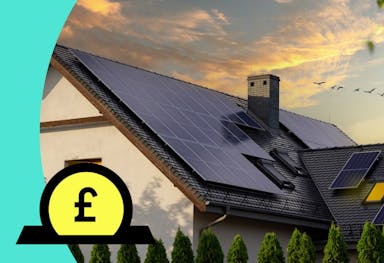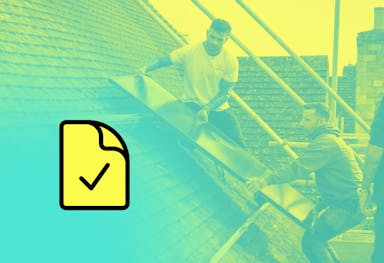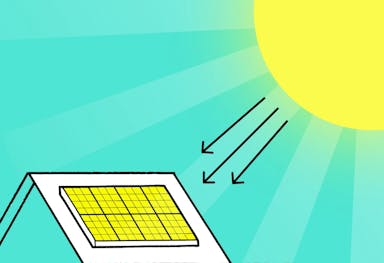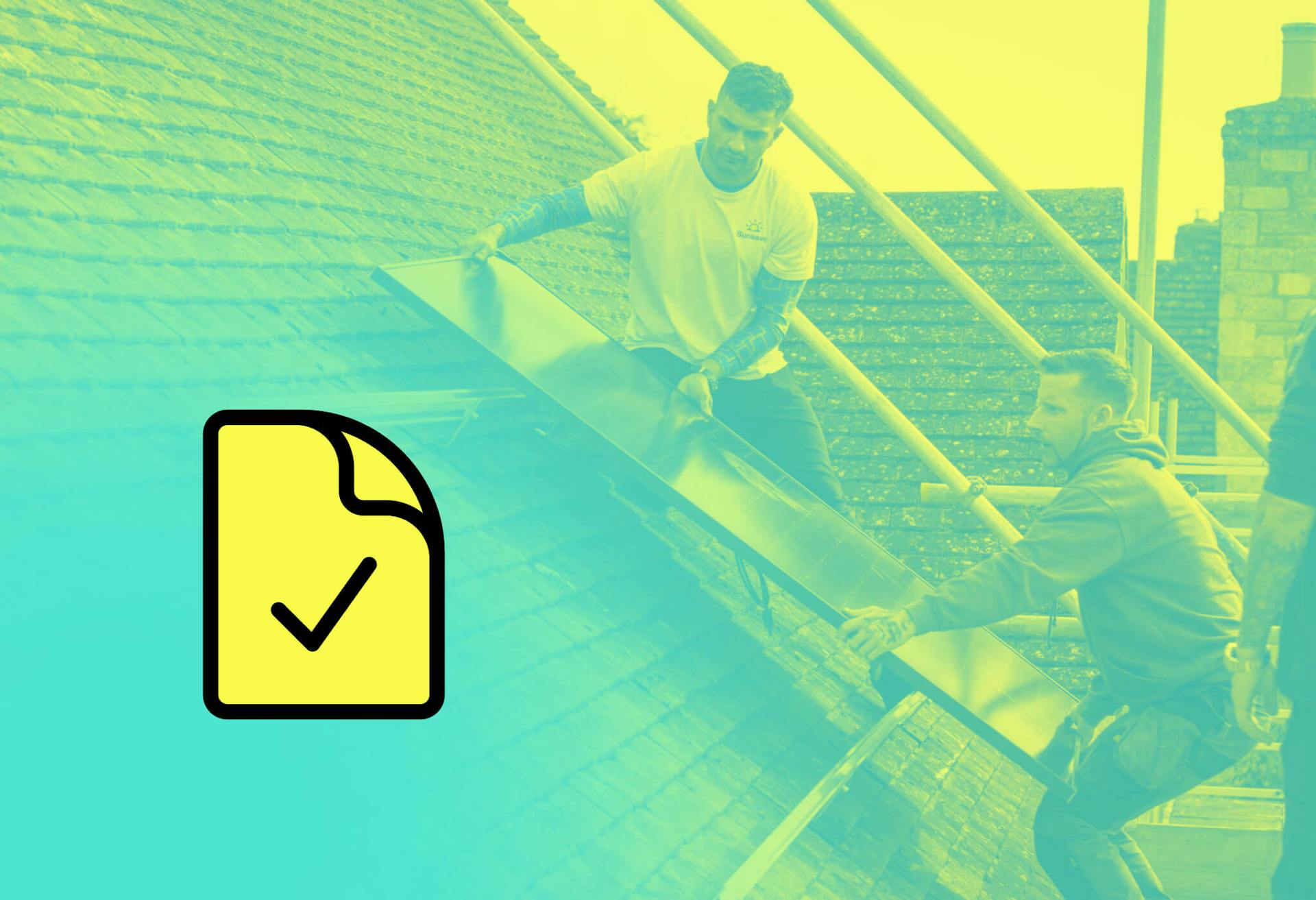- Solar advice hub
- Installation
- Solar panels on flat roofs: explored
Solar panels on flat roofs: explored
Learn about the difficulties associated with installing solar panels on residential flat roofs, and whether there are any solutions.


Why you can trust our content
We know that the solar industry is full of misinformation, but we only use reliable sources, including:
- Our experienced solar experts, installers and system designers
- Our own database of solar & battery system designs
- Authoritative bodies like MCS and the UK government




Calculate savings
What kind of home do you live in?
Calculate savings
What kind of home do you live in?
At a glance
Flat roofs present a unique opportunity for solar panel installation, as they offer a large, unobstructed surface area that’s ideal for capturing sunlight.
However, there are some challenges to consider when installing solar panels on flat roofs, such as potential structural issues, space limitations, and the need for proper waterproofing and maintenance.
This article will explore these benefits and drawbacks in more detail.
If you have a sloped roof and would like to find out how much a solar & battery system could save you, fill in a few details below and we’ll get back to you with an estimate.
Find out how much you can save
What kind of home do you live in?
Can you put solar panels on a flat roof?
You can install solar panels on a flat roof, but it’s much easier on the flat roofs of large, commercial buildings, which are typically very strong. The vast majority of residential flat roofs in the UK are not suitable for solar panels due to a variety of reasons (explored below).
Do solar panels still work on a flat roof?
Solar panels do work on a flat roof, but the panels need to be at a specific angle to generate the most electricity - around 35 degrees is perfect in the UK.
However, 35 degrees is rarely achievable on a flat roof because of increased exposure to high winds (and because solar panels on flat roofs can’t protrude more than 60cm above its surface), so the most achievable angle is somewhere between 10 and 15 degrees.
But even at this angle, solar panels are still quite exposed to wind, so they need to be weighed down with a ballast mount.
A ballast mount is usually an angled, plastic container filled with blocks, with the solar panel securely placed on top of it. In some cases, it can also be necessary to drill the ballast mount into the roof to make it even more stable.
This extra weight causes significant problems for a residential flat roof, and the drilled holes can make it even worse. More detail on this further down.
Verified expertEven if your flat roof has been deemed strong enough for solar panels, it’s usually not a great idea to proceed with the install. Most flat roofs tend to last about 10-20 years because of the long-term damage caused by sitting rainwater, so you’ll probably have to replace your roof halfway through your panels’ lifetime.
Tom Brehme
Technical Manager at Sunsave
Tom has worked in residential solar installation for more than a decade, and is a fully qualified electrician.
How are solar panels installed on a flat roof?
Strong winds can be dangerous for flat roof solar systems, so they need to be super secure from the outset. There are a few crucial steps to follow when installing solar panels on a flat roof:
1) To start the process, an engineer will carry out a structural survey to check if your roof is suitable for handling the solar panels' weight and the ballast used to secure them.
2) If your roof can bear the load, the installer will choose a ballast system to secure the solar panels. This involves using weights to hold the solar panels in place, protecting the integrity of the flat roof. But it can make the roof much heavier, so it's important that it can handle the added burden.
3) In some cases, the ballast mount will also be drilled into the roof to provide additional stability.
4) The solar panels are then arranged on the roof, set at an angle of about 10-15 degrees, and suitably spaced apart so that they don’t cast shade on each other.
5) Once the panels have been secured, the installer will then connect them to the inverter, which converts the direct current (DC) electricity generated by the panels into alternating current (AC) electricity for use in your home.
6) Finally, the system is connected to your home's electricity supply and the grid, ready to start generating electricity.
Difficulties with installing solar panels on a flat roof
Flat-roof solar installations come with several challenges that can complicate the process and increase the risk of lasting damage - which is why Sunsave currently doesn't offer flat-roof solar installations.
Let's look at each issue in further detail.
Structural weakness
As mentioned earlier, solar panels on a flat roof need a heavy ballasted mounting system to stay secure in high winds. And that ballast can make a solar panel system five times heavier than a typical non-ballasted system.
A ballasted solar panel can weigh around 100kg, whereas a non-ballasted solar panel is only about 20kg. On a roof with a 10-panel system, that difference of 1,000kg vs 200kg is significant.
To see if that weight is feasible for your flat roof, you'll need a qualified expert to do a structural survey to test its strength - however most residential flat roofs aren't strong enough to support heavy loads like this.
Leaks
In some cases, a ballasted mounting system will require extra stability, and this means drilling through the roof. Once you’ve got holes in your roof, heavy rainfall could cause leaks inside your property (as rain does not run off a flat roof in the same way it runs off an angled roof).
Suboptimal angle
The ideal angle in the UK for daylight exposure is 35 degrees, but getting to that height will require a heavier ballast mount in order to handle the high winds, which is not feasible for most flat roofs.
That's why flat-roof solar panels are often angled at only 10-15 degrees, while sloped residential rooftops can easily reach 35 degrees. Naturally, this decreases the output of a flat-roof system compared to an angled one.
Limited space for panels
It's a challenge to fit solar panels on a flat roof because of the limited space. Solar panels on flat roofs require a larger edge zone (i.e. distance from the roof edge) of 0.5-1m, unlike sloped roofs that only need 0.2m, which means less room for installation.
Solar panels on flat roofs also need more space between them so that they don’t cast shade on each other, which isn’t an issue for solar panels on a sloped roof.
Additional cost
It's pricier to install solar panels on a flat roof because of all the factors we've mentioned above.
The need for additional mounting equipment and in-person surveys makes the process longer, more complex and more expensive. And fixing a potential leaky roof can be a big financial burden.
As solar panel systems on flat roofs are less efficient, they won't save you as much on your electricity bills, and so the trade-off may not be worth it.
Do you need planning permission for solar panels on a flat roof?
As of December 2023, homeowners with flat roofs no longer need planning permission to install solar panels, thanks to changes in the government's permitted development rules.
However, there are still restrictions: solar panels on a flat roof can't protrude more than 60cm from its surface, and the highest point of the panels shouldn't surpass the highest part of the roof, excluding objects like chimneys.
This announcement is really only relevant for commercial flat-roof installations, given the unsuitability of residential flat roofs - as confirmed by Solar Energy UK CEO Chris Hewett: “The potential of installing solar power on large commercial rooftops is vast, its prospective capacity having been estimated at 15GW across the country.
“So eliminating one of the stumbling blocks on the way to fulfilling that opportunity is extremely welcome, helping to make British businesses more competitive by slashing energy bills, bolstering the economy and pushing us further towards net zero.”
What are the benefits of solar panels on a flat roof?
A key advantage of solar panels on flat roofs is the efficient use of otherwise unused space. They also offer easier access for installation and maintenance compared to solar panels on angled roofs, as technicians can move more freely and safely on a flat surface.
Another benefit is the flexibility of panel orientation. Unlike sloped roofs, panels can be faced in any direction on flat roofs for maximum daylight - though it's usually best to align panels parallel to the edges of the roof in order to make maximum use of space.
Finally, solar panels on flat roofs are often less visible from street level, preserving the property's aesthetic appeal and providing a discreet option for homeowners in conservation areas or with strict neighbourhood guidelines.
Summary
Flat roof solar panel installations come with a set of unique challenges, which can lead to significant issues like leaks, damaged roofs, and unexpected extra costs.
But for those with the right setup - mostly owners of large commercial buildings - a flat roof can offer a great use of unused space, with flexible panel orientation and easier maintenance access.
If you have a sloped roof and would like to find out how much a solar & battery system could save you, fill in a few details below and we’ll get back to you with an estimate.
Find out how much you can save
What kind of home do you live in?
Solar panels on flat roofs: FAQs
Related articles

Written byMelody Abeni
Based in London, Melody is a specialist green technology writer who has been covering sustainability, climate action and ESG for the past five years, after gathering operational experience in green investing and financial services. She has written for various industry publications, including renewable technology advisor The Eco Experts, and she holds a Master’s degree in law from Birkbeck University.








